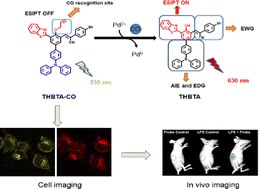A novel red AIE fluorescent probe for ratiometric detection of carbon monoxide in vitro and in vivo†
Abstract
As a significant signaling gas molecule, carbon monoxide (CO) has a crucial impact on various physiological and pathological processes in organisms, particularly in oxidative stress processes. Hence, designing and synthesizing a fluorescent probe that can effectively image CO in vivo holds immense significance. In this work, under the guidance of density functional theory (DFT) and time-dependent density functional theory (TDDFT), we designed and synthesized a red aggregation-induced emission (AIE) fluorescent probe THBTA-CO for CO detection and imaging. The fluorescent probe displayed green fluorescence emission at 535 nm before the CO response. However, upon CO response, with the involvement of Pd2+, the probe emitted red fluorescence at 630 nm. Furthermore, we successfully demonstrated the potential of THBTA-CO in visualizing both exogenous and endogenous CO in living cells. Significantly, THBTA-CO was effectively employed to image CO in lipopolysaccharide (LPS)-induced oxidative stress in mice. These findings convincingly establish THBTA-CO as a promising fluorescent probe for CO sensing and imaging, thereby facilitating a better understanding of CO's role in biomedical research.



 Please wait while we load your content...
Please wait while we load your content...